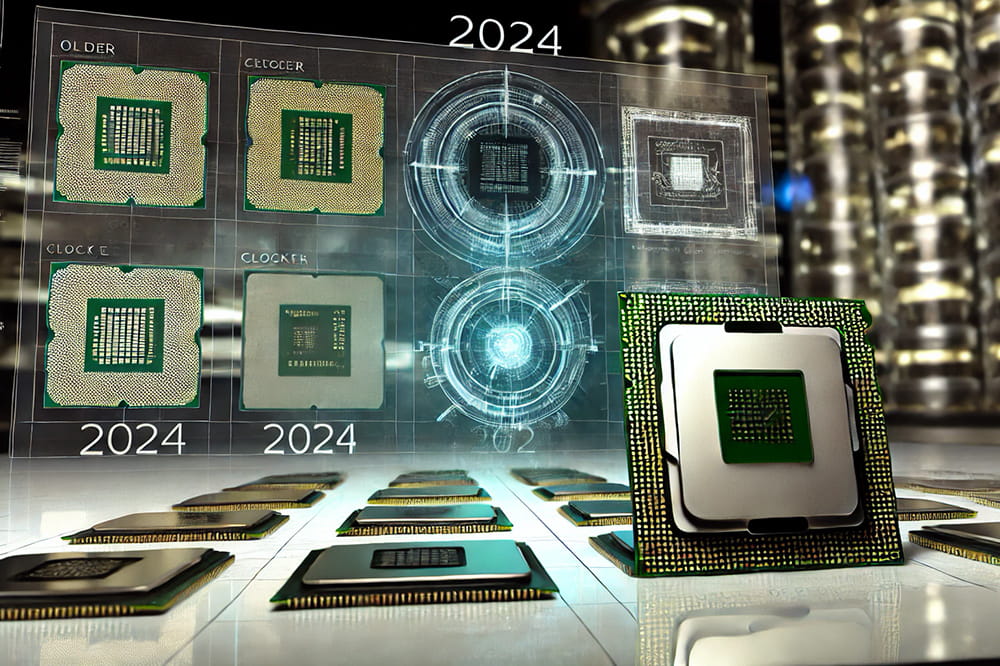PC processors have undergone rapid evolution in recent years, driven by technological advancements in semiconductor design and manufacturing. As user demands grow, especially in areas such as gaming, content creation, and artificial intelligence applications, CPU manufacturers have continuously innovated to deliver greater performance, efficiency, and processing power. In this article, we explore the evolution of processors and the trends that will define 2024.
Discover our range of processors in the following link,
The Evolution of PC Processors
1. The Growth of Multi-Core Processors
The evolution of processors has been marked by the shift from single-core processors to multi-core architectures. Instead of increasing the speed of a single core, manufacturers like Intel and AMD opted to increase the number of cores in a processor, enabling systems to handle more tasks simultaneously. This shift has been crucial in improving performance in multi-threaded tasks like video editing, 3D rendering, and multitasking.
- The rise of multi-core processors: In the mid-2000s, processors like the Intel Core 2 Duo and the first AMD Athlon X2 began the multi-core computing trend. Since then, we’ve seen a steady increase in core and thread counts, with consumer processors reaching 16, 24, or even 32 cores by 2024.
2. Increased Energy Efficiency
Energy efficiency has been a constant concern in the evolution of processors. As chips become more powerful, they also consume more energy and generate more heat. To counter this, manufacturers have improved manufacturing processes and adopted technologies like hybrid architectures.
- Smaller manufacturing nodes: Over the years, transistor sizes have shrunk from 45 nm in the early modern processors to 3 nm in 2024. This has allowed more transistors to fit into the same space, improving power without increasing energy consumption.
3. Development of Hybrid Architecture
Inspired by designs used in mobile devices, hybrid processors combine high-performance cores with high-efficiency cores. Intel, with its Alder Lake (and more recently Meteor Lake) architecture, has led this shift in the PC market, splitting its processors into P (Performance) cores and E (Efficiency) cores.
- Advantages of hybrid architecture: This design allows heavy tasks like gaming or video editing to run on the performance cores, while lighter or background tasks are handled by the efficiency cores, optimizing power usage and improving multitasking.
Processor Trends for 2024
1. Increased Performance for Gaming and Content Creation
In 2024, processors are being designed specifically to meet the demands of gamers and content creators. With the growing popularity of 4K gaming and 8K video editing, processors need to deliver higher multi-core performance, higher clock speeds, and improved overclocking technologies.
- Processors like the AMD Ryzen 9 7950X or the Intel Core i9-13900K have set new standards, offering multiple cores and clock speeds of up to 5.8 GHz, ideal for demanding games and high-performance editing software.
2. AI and Machine Learning Integration into CPUs
A key trend for 2024 is the integration of artificial intelligence (AI) and machine learning (ML) capabilities directly into processors. This will allow CPUs to automatically optimize tasks and dynamically adjust performance based on workloads.
- Intel is introducing Intel Gaussian & Neural Accelerator (GNA) technology in its next-gen processors, enhancing the handling of AI tasks such as voice recognition and image processing, while AMD has announced improvements in its AI acceleration cores to boost efficiency in specific workloads.
3. Chiplet-Based Processor Architecture
Another important innovation is the use of chiplet architecture, which is revolutionizing how processors are built. Instead of a single monolithic chip, processors are being designed with multiple chip modules interconnected, improving production efficiency and performance.
- AMD has led this approach with its Ryzen and EPYC processors, allowing more cores to be integrated and improving performance scalability. In 2024, this technology will become even more common, enabling manufacturers to reduce costs and enhance flexibility in processor design.
4. Processors Focused on Sustainability
Sustainability is becoming increasingly relevant in the world of processors. In 2024, more CPU manufacturers are expected to adopt environmentally friendly practices, optimizing both energy consumption and thermal efficiency.
- ARM has pushed low-power designs for PCs and servers, reducing environmental impact, while Intel and AMD are working on improving their product efficiency to reduce carbon emissions and energy consumption in both factories and final products.
5. Rise of ARM Processors for PCs
ARM processors, traditionally associated with mobile devices, are gaining ground in the desktop and laptop PC market due to their low power consumption and high efficiency. With the success of the Apple M1 and M2 ARM-based chips, other manufacturers like Qualcomm are expected to continue developing ARM processors capable of competing with traditional x86 architectures.
- By 2024, we may see a wider adoption of ARM processors in PCs, especially in ultra-light and highly energy-efficient laptops, offering longer battery life and optimized performance for everyday applications.
Conclusion
The evolution of PC processors has been remarkable, and the trends for 2024 show a future full of innovations that will change how we use our computers. From the growth of multi-core architectures and AI technologies to the expansion of ARM processors and the adoption of sustainability, processors are becoming more powerful, efficient, and specialized. For gamers, content creators, and professionals, 2024 promises to be an exciting year with new CPUs that offer unprecedented performance.






